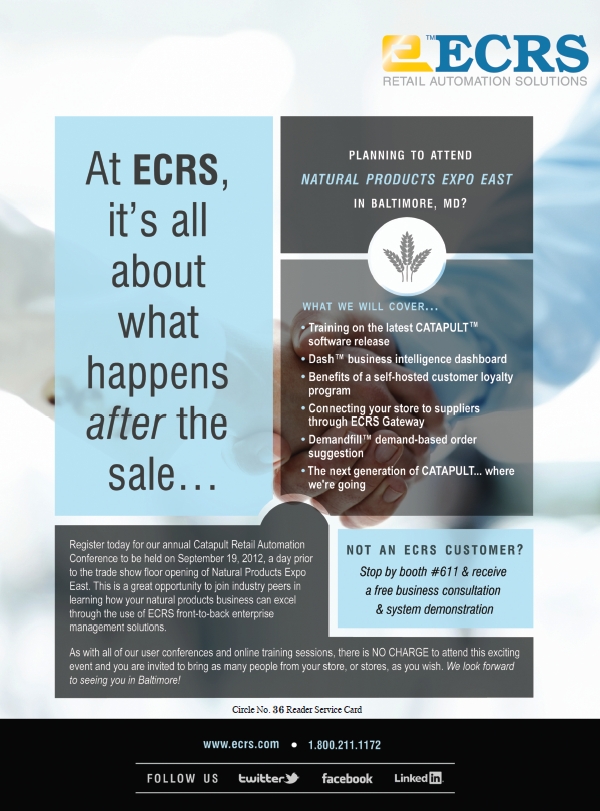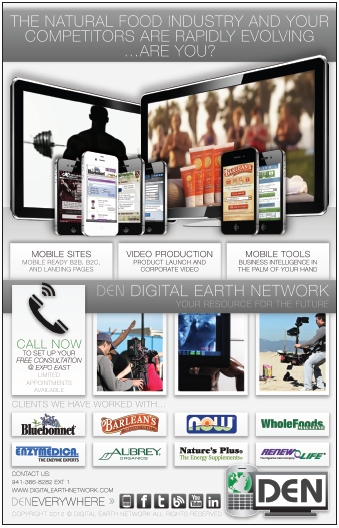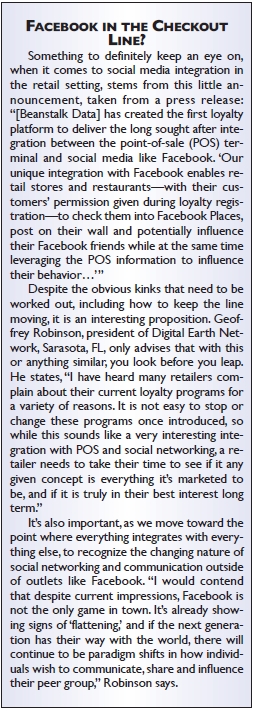Countless tasks are required of you as a business owner and natural products retailer. Sometimes, you are spread too thin, or feel powerless to effect the changes you’d love to see for your store. Alas, there’s only so much one human being with one staff can do. Well, how about acquiring a few electronic allies, or upgrading the ones you have?
Going Mobile
Just about everybody today is online. “Now that shoppers turn to the Web first to make health and wellness decisions, we help retailers take advantage of this trend,” says Bill Schneider, director of marketing for Aisle7, Portland, OR. But the key for commerce, in the present moment, is to figure out where they are online. “Mobile is an area of particular interest. According to numerous sources, mobile web traffic will eclipse desktop traffic sometime in 2014,” he says.
But the mobile revolution does not need to be left entirely up to consumers. With the service suites available to retailers today, Schneider says, shoppers can find the tools they need on store Web sites, on mobile phones and in stores to make good health decisions. “Retailers are being increasingly presented with technological advances in mobile and video applications that help educate and communicate with consumers,” says Geoffrey Robinson, president of Digital Earth Network, Sarasota, FL.
Traditional Web sites don’t tend to translate well when viewed on mobile devices, so a mobile optimization set up is often needed. There are, of course, special benefits from making your store’s and your vendors’ brand messaging available for customers on the go. A mobile brand Web site that Robinson’s company created for a cosmetics firm, for instance, includes a robust education section featuring questions about hair and skin type. Once consumers answer these questions, they are directed to products best suited to their needs.
Ideally, communications with the mobile consumer can include features like coupon delivery, store information, health content and alerts about upcoming store events, explains Dan Clarke, CEO of Living Naturally, Venice, FL. “This personal contact with the customer is a crucial step in building and securing a loyal customer base,” he says. His company, for instance, has created a tool that can deliver a store-branded mobile application directly to customers’ smartphones.
Health on Demand
Schneider indicates that over 86% of “mobile moms” use their phones while grocery shopping. This is why he claims the next frontier for grocery stores involves mobile decision-making tools for in-aisle use. His company, he says, is just rolling out its first offering in that vein, called Mobile Vitamin Advisor. Activated through quick response (QR) codes, this tool can provide shoppers with science-based supplement recommendations based on their personal health, lifestyle and dietary choices. Once the QR code is scanned, a quick questionnaire pops up that feeds into an algorithm, which then provides a personalized report displaying helpful supplement options.
A similar product is available for retailer Web sites, and will be available at in-store kiosks as well, so non-mobile users can access this information while shopping. It can be customized to support a retailer’s brand message. Choosing between supplements can be confusing for consumers, especially those new to the subject, says Schneider. Tools like these increase confidence, and have proven to increase “add to cart” rates on the Web. He believes the same will hold true of the mobile offering.
Made to Order
“Certainly, our industry has made a big leap toward greater efficiency over the years with the institution of intelligent, electronic ordering. The purchasing process has always been something retailers have strived to streamline, allowing them to spend more time where it matters most—on the sales floor,” says Clarke. Prepare to spend even more time on the sales floor, while making more informed ordering choices in a more efficient manner.
 Retailers are now better able to empower themselves, and manufacturers to empower their retail representatives, with what Robnison calls Business Intelligence. “This is just the beginning of a paradigm shift in the arena of B2B mobile tools that help retailers and manufacturers alike reach and market to consumers more effectively,” he says. These powered-up ordering systems can be “platform independent.” Representatives and retailers will, of course, use a variety of mobile devices, so the ability to access this technology from virtually any device is important. “We call it BYOD (bring your own device), which means that regardless of the phone, tablet or equipment you are using, you are able to utilize our software seamlessly,” says Robinson.
Retailers are now better able to empower themselves, and manufacturers to empower their retail representatives, with what Robnison calls Business Intelligence. “This is just the beginning of a paradigm shift in the arena of B2B mobile tools that help retailers and manufacturers alike reach and market to consumers more effectively,” he says. These powered-up ordering systems can be “platform independent.” Representatives and retailers will, of course, use a variety of mobile devices, so the ability to access this technology from virtually any device is important. “We call it BYOD (bring your own device), which means that regardless of the phone, tablet or equipment you are using, you are able to utilize our software seamlessly,” says Robinson.
“At the shelf” access can give unprecedented insight into product performance and demand. “A retailer or rep can log in to the ordering site and see how a product is selling nationally, regionally or by state,” Robinson says. There is also the pre-programmed ability to create a list of best-selling items that your store isn’t currently carrying, helping you to spot trends you are not taking advantage of with a simple click, as Robinson explains.
Demand-based ordering, like that available with DemandFill from ECR Software Corp., Boone, NC, can provide dramatic results, according to Ashlee Olson, vice president of marketing. This advanced method of inventory management and integration with one’s suppliers is suggestion-based, and when combined with her company’s electronic ordering system, allows for order transfer to all suppliers.
Hey, You! Get Onto This Cloud!
The most important benefit of technology for retailers right now, in Olson’s view, is the ability to access store information anywhere and at anytime. “This helps manage every aspect of critical retail operations…detect loss, determine staffing and so much more,” Olson says. Dash by Catapult from ECRS is one example of this technology. It allows authorized users to access store information in the form of graphical widgets, from anywhere with Internet access, using most smartphones and tablets. “So, if a small business owner with limited staff resources goes away on vacation, he or she can still monitor all vital store information, even from a beach chair watching the waves. The idea is to provide all retailers with 24/7 visibility and business intelligence to fuel growth,” she says.
This type of cloud-based reporting is also found with products like WebPoint Report Studio, from Auto-Star Compusystems Inc., Medicine Hat, AB, Canada. Robert Symmonds, president of Auto-Star, describes some of its capabilities: “Our Geospatial report graphically maps customer sales by zip code, which is a great tool for deciding where to send flyers or open your next store location. We have recently added the ability to send important information such as net sales and our daily cash report via email or text message.” It’s not all just for your convenience as a store owner. This technology will underscore your store’s environmental message and extend conveniences to your customers. “We are also looking at adding the option to email receipts to customers, as this eco-friendly feature is popular among health & natural product retailers,” Symmonds says.
Many of these services can sometimes be had under  one umbrella, a notion Olson calls complete store integration. The days where multiple fronts were individually managed as a retailer are gone, she claims, stating, “No longer do you need one system for inventory, one system for loyalty, one system for POS, one system for back office…the trend is to combine all systems into one easy-to-use and maintain system that automates all areas of the business.” Some of the advantages of this approach include reduced costs, improved accuracy and simplified staff training. Olson considers complete store system integration especially suited to small-to-medium business owners, who often have limited time and resources available to them.
one umbrella, a notion Olson calls complete store integration. The days where multiple fronts were individually managed as a retailer are gone, she claims, stating, “No longer do you need one system for inventory, one system for loyalty, one system for POS, one system for back office…the trend is to combine all systems into one easy-to-use and maintain system that automates all areas of the business.” Some of the advantages of this approach include reduced costs, improved accuracy and simplified staff training. Olson considers complete store system integration especially suited to small-to-medium business owners, who often have limited time and resources available to them.
Be More Sociable
You would be missing the boat, in the current consumer climate, if you were to upgrade your store with all of the above while remaining behind in your outreach efforts. The place that many consumers, especially young ones, are waiting to be reached out to is on social media. It is important, if you engage in social media marketing, to extend your brand message while not being intrusive or overbearing. “Employees often become the ‘face’ or ‘personality’ of a store—and social media and mobile apps become extensions of that personality, continuing even after the customer has made their purchase and gone home,” says Clarke.
Symmonds feels that social media outlets have taken the world by storm, and said their integration into the retail experience is a challenge that point-of-sale providers have had to meet. A new offering from his company takes one intriguing stab in that direction. It allows their existing electronic store promotion engine to automatically post status updates on the social media outlet of a retailer’s choice. “The application will post the promotion name, dates, and allow the retailer to add more information to include in the post,” he says. For example, your natural products store may arrange for a nutritionist to come talk to customers about diabetic supplements. This gets posted automatically to Facebook, along with information about a promotion or coupon event tied to it.
Symmonds notes that his firm’s loyalty program software is now integrated with social media, including the ability to announce special offers to loyalty customers. “We believe these features are good first steps for retailers to enter the social media world of marketing. By implementing these abilities in conjunction with their point-of-sale platform, retailers will be ready to further embrace social media as the capabilities of these platforms continue to expand,” he says.
Natural retailing and social media can be a marriage made in heaven, according to Schneider. “Facebook and Twitter provide a great opportunity for natural product retailers, particularly since they have such a great story to tell and an involved community base,” he says. A solution from his company called Aisle7 Content Explorer allows retailers access to all of the health topic articles that Aisle7 publishes. He says, for example, that one could locate an article on hay fever, and tell social media followers about it this way: “Hay fever! How do you plan to cope? Check out this article…” and begins a conversation. He says that users have found it stimulates discussion and activity in their social media outlets. One user from a club retail chain built a Facebook “quit smoking” promotion at the beginning of the year that included an article on “8 Tips to Stop Smoking for Good.” This increased its Web site conversion rate to four times its standard rate. WF
Published in WholeFoods Magazine, August 2012










